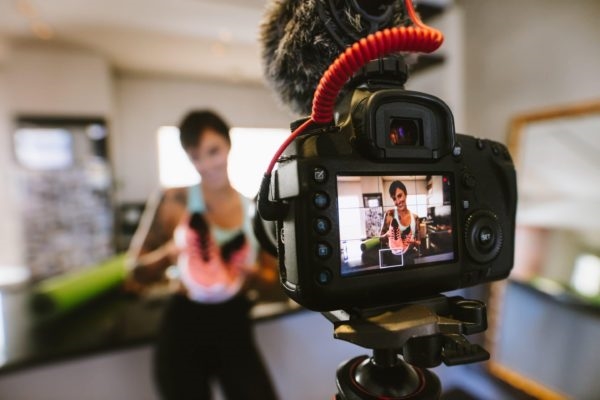— July 26, 2019
Social media influencer marketing is a powerful digital marketing strategy that can create quick sales conversions, increase brand visibility and drive genuine engagement for your company.
Influencers are people who affect and inspire others through social media platforms. Companies can work with influencers to build name recognition and brand awareness among consumers through the already established relationships social media influencers have with their followers.
Why Do Brands Work With Social Media Influencers?
Working with social media influencers is a beneficial marketing strategy because of its high return on investment, low barrier to entry and increased branding capabilities. In a 2018 survey, the Association of National Advertisers found that 75 percent of brands use influencers for promotional strategies.
Influencers are the new word-of-mouth marketing strategy and are now the fastest growing online customer acquisition method. According to a 2019 consumer survey by HubSpot, 20 to 50 percent of all purchasing decisions are made based on word-of-mouth marketing.
Influencers have the ability to sway people into responding to a call to action and bring in more sales and conversions for your brand. Research done by Twitter in 2018, determined 40 percent of Twitter users have made purchasing decisions as a direct result of an influencer’s tweet.
Influencers present their content as if they have close relationships with their followers, creating a feeling of loyalty and genuine authenticity among their fan base. This dynamic helps a sponsored post to appear more earnest and the follower is more likely to trust and buy into the advertisement, making it an effective strategy to create relationships with a consumer base and drive sales:
- 71 percent of consumers are more likely to make a brand purchase based on a social media reference than an ad
- For every dollar invested on an influencer marketing, companies received an average return on investment of $ 7.65, making influencer marketing cost effective.
Three Types of Social Media Influencers
1) General Influencer: These influencers have over a million followers typically, sometimes even multiple millions of followers. This is most likely who you think of when you hear the term “influencer.” For example, celebrities such as Kendall Jenner, Taylor Swift and Zac Efron are well-known influencers. They have huge, diverse followings and their fame creates an immense amount of exposure for your paid social post. Typically, their fame carries to international audiences, and people are aware of these influencers without being directly interested in them. These influencers are the most expensive and are hard to reach due to their high demand. Businesses use these influencers for quick results, increased brand awareness and new launches.
2) Industry Influencer: These influencers are important people with a large follower base within a specific category, for example, chefs, sports figures and beauty gurus. You can expect customers who are interested in a specific category will be well aware of these industry influencers. They provide a fantastic way to dominate a specific target market or category related to your company or product. These influencers are easier to find and are more cost-effective than general influencers. While they have lower visibility in total numbers than general influencers, they tend to have more engaged, highly-targeted followers, making them effective for sales growth.
3) Micro-Influencer: These individuals often have between 1,000 to 1,000,000 followers, typically around 25,000. These influencers are often only well known in niche categories but are considered experts to be extremely trusted and tend to have the most genuine engagement with their followers. They are often highly sought after, giving companies the best return on investment, while having a lower price tag than other influencers. Companies often spread their influencer budget among micro-influencers, to decrease risk and increase brand visibility among niche audiences.
How To Refine Your Influencer Strategy

It’s important to understand what you are hoping to gain from marketing through social media influencers. You need to know what your ideal consumer will respond to.
1) Know your target audience. For any marketing strategy, you need to know the target audience you are trying to promote to. If you have multiple demographics, you might need numerous social media influencers, but focus on your top selling consumer base first.
2) Know your target audience’s interests, who they follow and on which social media platforms. Once you have determined the ideal consumer you are aiming to appeal to, do an analysis of what topics and people appeal to them; this will ensure the influencer you choose will be effective and relevant to your brand. It is also essential to understand the social media platforms your key demographic groups engage with to ensure that your post is readily visible to your audience.
3) Budget. Set your budget for social media outreach; this will help narrow down the types of influencers you can afford and the frequency of use. There is no denying that large, expensive influencers can do tremendous things for your brand, but they may not be a sustainable model or cost-effective for your company.
How To Find The Right Influencers For Your Company
Once you have a broad picture of what you want your social media strategy to look like, it’s time to get into the nitty-gritty of finding the specific influencers. Utilizing influencer marketing auditing tools to project and measure influence along with due diligence and looking out for red flags can help you locate your best influencers.
Looking at these main factors will give you a helpful sense if the influencer’s followings are real, loyal and socially-engaged.
1) Follower count. This is the number of people that subscribe to an influencer’s social media updates. The number is usually easy to find on users’ profiles across social media platforms. If an influencer has excellent content, but few followers, then your promotion will not be as visible and will not increase your brand awareness or boost sales growth as quickly.
2) Engagement. Likes, comments and shares give a strong indication if they genuinely have a loyal following and can influence people to act. An influencer with a massive audience but little engagement won’t have an influential reach. It also suggests their followers may have been purchased; neither type is a positive one to be associated with.

3) Values. Choose an influencer that has consistently shared similar visuals, voice and values as your brand, as well as these elements consistently used across their social media presence. Just like a standard company, influencers need to establish consistent branding in order to effectively share their message with their audience. Influencers with inconsistent branding tend to have a larger turnover in followers, less loyalty and lower overall engagement.
4) Overexposure. Avoid sponsorship spammers. Be aware of influencers who have already partnered with many other brands; this creates sponsorship saturation where the advertisement doesn’t resonate with the audience and is seen as ingenuine.
Online Tools for Influencer Auditing Marketing
Finding influencers, checking followers and monitoring engagement rates is a lot of work, but don’t fret! There are many online influencer auditing and search tools that will find, analyze and quantify influencers for you, so you can focus on strategic and creative aspects of your influencer marketing plan.
Social media influencers seem to be everywhere, but it can be hard to find ones that fit your brand; fortunately, there are helpful online tools that will help you find and evaluate social media influencers.
Online social media influencer auditing tools verify if an influencer is right for your brand, confirm they have an active audience and provide you with marketable insight on the demographics of their audience. It’s essential to verify a social influencer hasn’t falsified their influence through purchasing followers and engagement; your company won’t receive the desired results from a fake audience.
According to the Social Chain Group a study found that 25 percent of influencers used false engagement methods, including buying automated followers, and 40 percent of comments on influencers’ sponsored posts came from bots. This highlights why it’s important to look at the influencer from a creative or personal level, as well as the influencer’s statistics. Remember, the numbers don’t lie!
Experiment with these online influencer auditing tools to help find and analyze whether an influencer is authentic and right for your company.
- Followerwonk is free a Moz product that helps you discover influencers on Twitter by analyzing trending hashtags and influencers; it will also cross-reference their tweets, bios and profiles with the usage of keywords to see if it matches your company branding. It will allow you to compare influencers, track their growth, see when their followers are most active and view their locations as well.

- HypeAuditor is the leading Instagram social media auditing tool; it will find top trending Instgrammers, ranked by the number of quality and engaged followers and keep track of influencers previous rankings. It will show you of the main topics the influencer posts about, their audience’s geographic location and age, and the estimated authentic engagement.
- Buzzsumo has an influencer auditing tool that allows you to discover influencers and evaluate influencer data. Their software will find emerging influencers in a specific field or location, give you a synopsis of their average engagement rates and their projected engagement rate for their follower count to compare to and more!
- Buzzweb is a tool that will determine follower’s authenticity, engagement rates and level of influence in relation to other influencers, by assigning an audience quality score, giving you an idea if an influencer’s followers are actually engaged. Buzzweb will also provide crucial data on their audience’s demographics like gender, age and location, in order to paint a clear picture of an influencer’s standing and if it’s the right fit for your brand.
- Social Bond is an Instagram centric metric tool that allows you to search influencers and see influence ratings based on followers vs. average engagement rates per post. It even allows you to peer in the influencer’s audience demographics.
- Sprout Social is a Twitter-centric influencer auditing tool that will help you identify trending hashtags and Twitter influencers. It analyzes an influencer’s Twitter followers and gives you side-by-side Twitter profile analytics, including their growth over time.
Once you have found which social media influencers you want to target, read our article on 10 Important Influencer Marketing Strategies you should know about; this will give you key strategies to utilize your influencers to their full marketing potential.
Digital & Social Articles on Business 2 Community
(85)
Report Post






